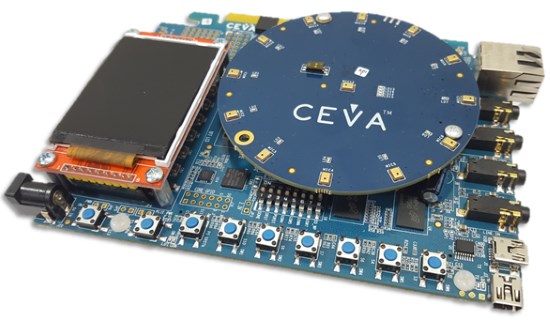The CEVA-X2™ is an advanced DSP optimized for intensive sound processing applications. It has been specifically designed to tackle multi-microphone speech processing...
Overview
The CEVA “smart and connected” development platform is the ultimate tool for algorithm and system designers who want to develop and prototype audio and sensing solutions using real-time, full-speed silicon.
The platform is built around a 500 MHz audio-and-sensing CEVA DSP chip fabricated using the IoT-centric SMIC 55 nm LP process, which also incorporates a rich integrated set of peripherals and interfaces. A multi-microphone daughter board with 13 microphones complements the high-speed silicon for development of sound‑pickup algorithms (for example, far-field voice pickup, beamforming, acoustic echo cancellation, de-reverberation and so on).

Using the included DSP RTOS, the platform provides ample processing power for multiple functions running concurrently. This enables prototyping of real-world use cases, such as always-on sensing, local intelligence, and high-throughput multi-microphone processing, all of which are supported by the “smart and connected” platform.
Because low-power signal processing is a key element in smart IoT device differentiation, the platform also provides real-time power measurement and display, which enables developers to optimize and power-tune their DSP firmware.
Benefits
The CEVA "smart and connected" development platform enables rapid prototyping and development of systems based on CEVA's audio and sensing DSPs.
Fully compatible with CEVA's audio and sensing ecosystem
Can run real-time applications using full-speed silicon
Simple to optimize system power consumption
Main Features
- 500 MHz CEVA audio-and-sensing DSP development chip
- DSP subsystem of integrated peripherals (TDM, DMA, I2C, I2S, ICU, Timers, GPIOs)
- Multi-microphone daughter board
- On-board dual ARM Cortex-A9 host CPU running Linux for complete CPU and DSP system prototyping
- Peripherals and interfaces, including:
- A dual on-board digital MEMS microphone
- I2C I/F for connecting sensors
- Audio CODEC with digital and analog audio in/outs
- USB, UART, PCIe, and Ethernet ports
- User-configurable FPGA, GPIOs, DDR memory, SD card, and Bluetooth dongles for wireless operation and LCD display
- Arduino connectors and drivers, which enable Arduino modules to be connected to the board, leveraging a massive ecosystem of Arduino-related products
- A wide variety of available software modules
- RTOS and DSP libraries to accelerate software development
- Multiple demos with source code included to jumpstart system design



